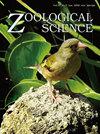海蜘蛛的殖民内源性外生菌。
IF 1
4区 生物学
Q3 ZOOLOGY
引用次数: 0
摘要
我们报道了海蜘蛛(Pycnogonida)表面的内源性外生物。经鉴定为蛱蝶属(蛱蝶科)。内原体为群居体,有3种动物,经形态学和分子系统发育鉴定为巴氏体(Barentsia sp.,巴氏体科)。最大的动物有8根触手,长约0.7毫米,比大多数殖民地的内生物种要小。我们从内蛋白中测定了18S rRNA和28S rRNA基因的部分序列。在基于18的最大似然树(1507个字符)中,内原群是巴伦支的姐妹类群。本文章由计算机程序翻译,如有差异,请以英文原文为准。
Colonial Entoproct Epibiotic on a Sea Spider.
We report an entoproct epibiotic on the surface of a sea spider (Pycnogonida). The pycnogonid was identified as Nymphon sp. (Nymphonidae). The entoproct was colonial, with three zooids, and was identified both morphologically and by a molecular phylogeny as Barentsia sp. (Barentsiidae). The largest zooid had eight tentacles and was about 0.7 mm long, smaller than for most colonial entoproct species. We determined partial sequences for the 18S rRNA and 28S rRNA genes from the entoproct. In an 18S-based maximum likelihood tree (1507 characters), the entoproct was the sister taxon to Barentsia gracilis.
求助全文
通过发布文献求助,成功后即可免费获取论文全文。
去求助
来源期刊

Zoological Science
生物-动物学
CiteScore
1.70
自引率
11.10%
发文量
59
审稿时长
1 months
期刊介绍:
Zoological Science is published by the Zoological Society of Japan and devoted to publication of original articles, reviews and editorials that cover the broad field of zoology. The journal was founded in 1984 as a result of the consolidation of Zoological Magazine (1888–1983) and Annotationes Zoologicae Japonenses (1897–1983), the former official journals of the Zoological Society of Japan. Each annual volume consists of six regular issues, one every two months.
 求助内容:
求助内容: 应助结果提醒方式:
应助结果提醒方式:


